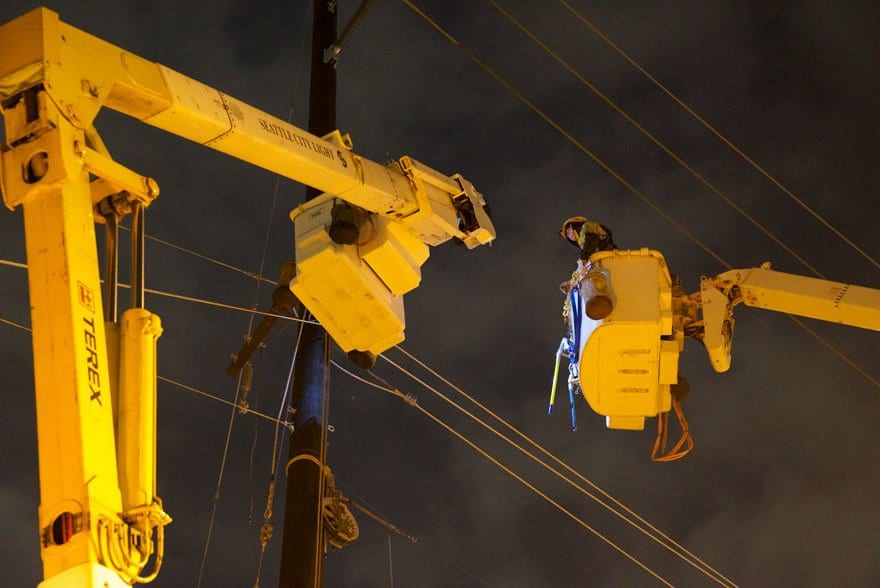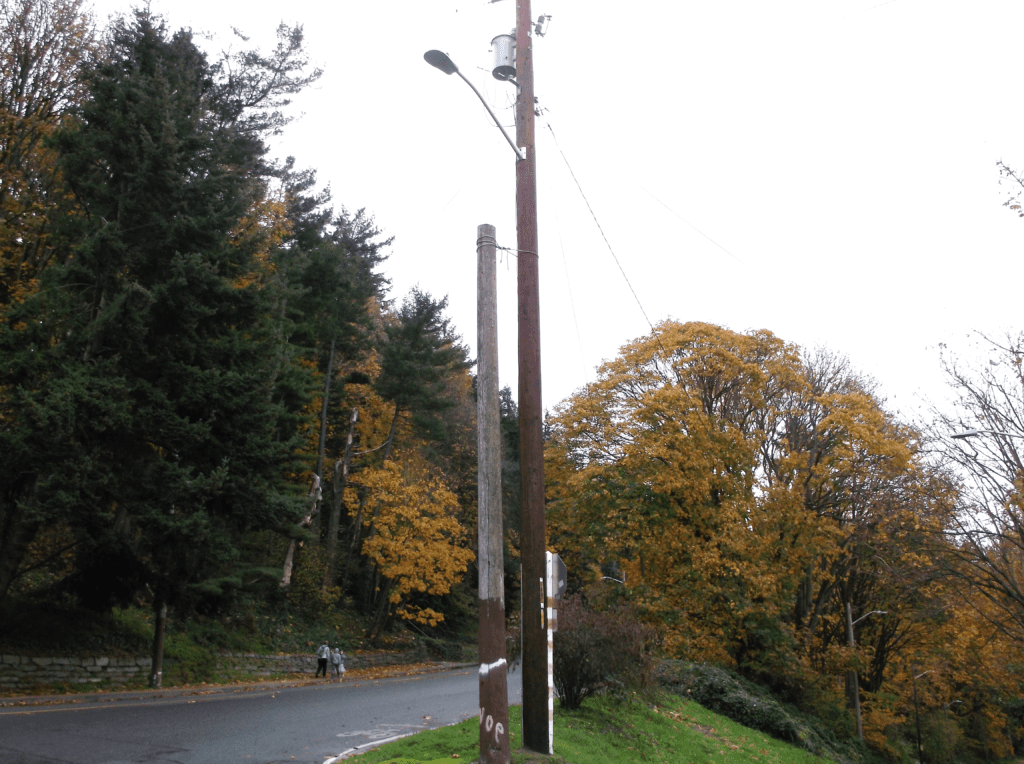
Project Description
Seattle City Light is replacing aging utility poles throughout the utility's service area to enhance safety and electrical reliability. City Light will require scheduled power outages for crews to complete this work safely. We acknowledge that power outages are never convenient, especially under the current circumstances. We appreciate your patience as we work to improve the electrical infrastructure and enhance the safety of your neighborhood by completing this essential work.
Location
Crews are working throughout City Light's service territory to replace aging poles past their service life.
What's Happening Now?
Program Update (January 2024): Seattle City Light crews and contractors installed 173 poles in January. In total, 6,071 poles have been replaced throughout this program.
View our progress here: Accelerated Pole Replacement Program Graph.
Community Benefits
- This project will enhance safety by replacing aging utility poles from our system. The installation of new poles, wires, and equipment will also improve system reliability.
Anticipated Impacts
- Customers can expect temporary parking, sidewalk and traffic restrictions during this project. Flaggers will direct traffic through the work zone as needed.
- Construction noise may occur during work hours.
- Power outages are required to do the work safely. City Light will notify affected customers in advance of any planned outage.
- The new poles will be placed alongside pre-existing poles and meet the standards required for overhead power line construction. Some poles in the area may be slightly taller and wider than existing poles.
- Once crews have relocated the electrical equipment, they will cut down the old poles to the level of the highest communications cable. Seattle City Light is working closely with Lumen (formerly known as CenturyLink) to expedite this process. We will continue to monitor/coordinate these efforts as needed to facilitate the removal of old poles.
Despite pandemic, City Light meets 2020 pole replacement goals (April 5, 2021)
Accelerated Pole Replacement Program: July 2020 Update
Seattle City Light: East Marginal Way Storm Investigation Recommendations Report (December 2019)
Seattle City Light: East Marginal Way Storm Investigation Report (October 2019)
Frequently Asked Questions
Seattle City Light is replacing aging utility poles throughout the utility's service area to improve and upgrade electrical reliability. During this work, electrical wires and equipment will be replaced and relocated to the newly installed poles.
Crews will place the new poles alongside pre-existing poles. They will meet the standard heights and widths required for overhead power line construction. New poles in your area may be slightly taller and approximately two inches wider than existing poles. This work is part of a more significant effort to accelerate and better prioritize pole replacements throughout the utility's service area. Recommendations were made to improve this process based on the East Marginal Way storm incident in April 2019.
City Light assigned a project manager to oversee the accelerated pole replacement program and coordinate the pole replacement work with an emphasis on safety. Crews will prioritize replacements for poles with the least strength. City Light has also reprioritized existing staff resources and used emergency contracting processes to hire vendors and accelerate pole replacements.
City Light maintains approximately 91,000 wooden poles in its service territory. The utility worked with a third-party vendor to develop the "Inspection Procedures for Wood Pole Assessment." Another third-party vendor carries out these procedures. The inspection process includes a visual, sound and bore partial excavation inspection as demonstrated in this 2017 Seattle Channel video and described in this 2014 blog post.
In 2008, City Council requested that City Light implement an asset management program. A baseline was established from 2009-2010 when the utility inspected all wooden utility poles visually and using a basic hammer-sounding technique. This technique involves hitting a pole with a hammer; a healthy pole should produce a solid-wood sound while a pole with internal decay will produce a hollow sound. From 2011 on, we began inspecting approximately 10% of our wooden utility poles per year using more thorough boring inspection and subsurface excavation methods. Seattle City Light has been on a steady-state program cycle to reinspect and test 10% of our poles per year. Depending on testing results, poles will be treated or replaced as appropriate. With this strategy, we will visit all poles once every ten years.
Pole longevity can vary widely based on the wood species, treatment and the environment where it is placed. A typical modern pole should last 40-60 years. City Light does have some poles much older than that; older poles were often made from old-growth timber and subject to preservation methods that extended the useful life much more than modern treatments.
As part of the development of the asset management program in 2008, City Light hired a consultant to develop a classification system for rating poles. In 2011, the utility updated this classification system (see table below). Each pole inspected is assigned a priority rating from 1 to 5; poles identified as P1 or P2 are flagged for replacement.
| Priority Rating | Maintenance Required | Action Needed |
|---|---|---|
| P1 | Replace | Pole will need to be replaced |
| P2 | Replace | Pole will need to be replaced |
| P3 | Reinforce | Pole will be assessed for reinforcement (through steel stays and/or pole trusses) |
| P4 | None | Pole is serviceable, no action needed |
| P5 | None | Best pole condition, no action needed |
Table: Pole Classification System
Depending on the availability of funding and resources, we are looking to replace 1,400 - 2,000 poles annually over the next five years. City Light will address any newly identified weakened poles in our regular annual program.
Seattle City Light continues to actively respond to three pole failure events that occurred on East Marginal Way in Tukwila, Wash. Crews are actively replacing poles along this area to improve structural and electrical reliability.
The utility has a dedicated technical team that meets regularly to identify the root cause of the failures and provide continued analysis and recommendations for future pole replacements. Tools like 3D maps and structural models also assist our team with ensuring that pole engineering design standards are up-to-date. Preliminary findings from the events have led to reduced pole heights for future installations and identified additional pole replacements outside of our standard inspection process.
- Taller poles are needed to meet safety requirements for higher voltage electricity.
- Proper clearances are required between power lines so that crews can work safely and efficiently when performing repairs.
- Minimum clearances from the communication lines of other utilities are required.
- Taller poles provide minimum height clearances for service lines to individual homes.
Poles that do not require replacement may be reinforced by trussing or installing steel stays. These methods extend the life of poles at the higher end of the remaining strength. Pole trusses and steel stays are cheaper and faster than replacement.
Double poles exist when a crew installs a new utility pole next to a pre-existing pole scheduled for removal. When City Light installs new utility poles, crews will transfer their equipment and wires onto the new pole. Other communication utilities may also have equipment on the pre-existing pole that will need to be transferred to the new pole before removing the old pole. This process can take several months to complete.
Seattle City Light is working with Lumen (formerly known as CenturyLink) and other communication companies to expedite the pole removal process. We will continue to monitor and coordinate these efforts as needed to facilitate the removal of old poles.

Crews may secure the new pole by anchoring or tying it to the old pole until the utility or communications companies have transferred their equipment. This method is standard practice and common among utilities.